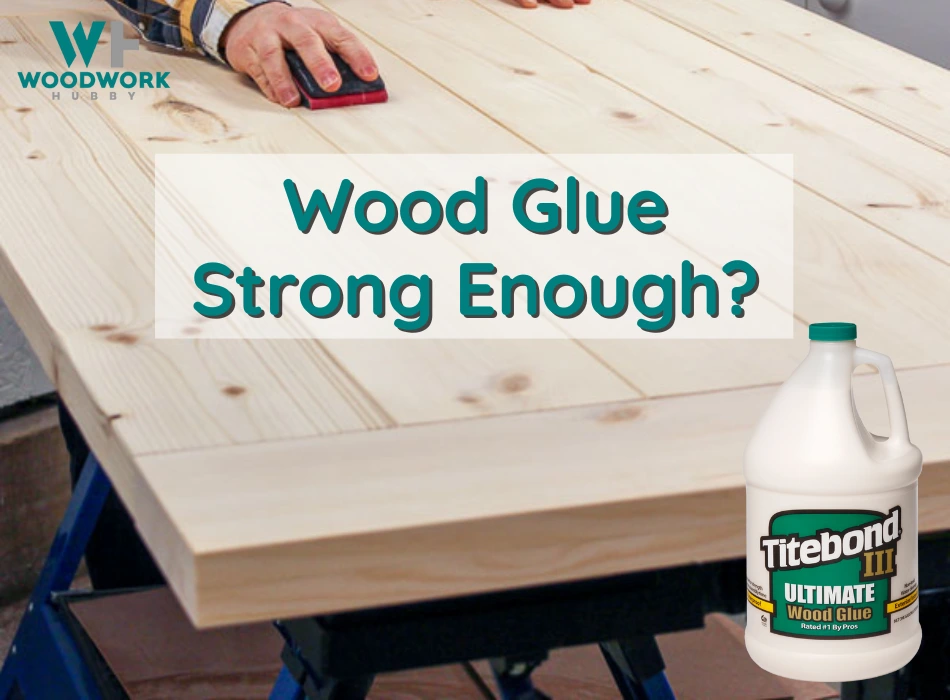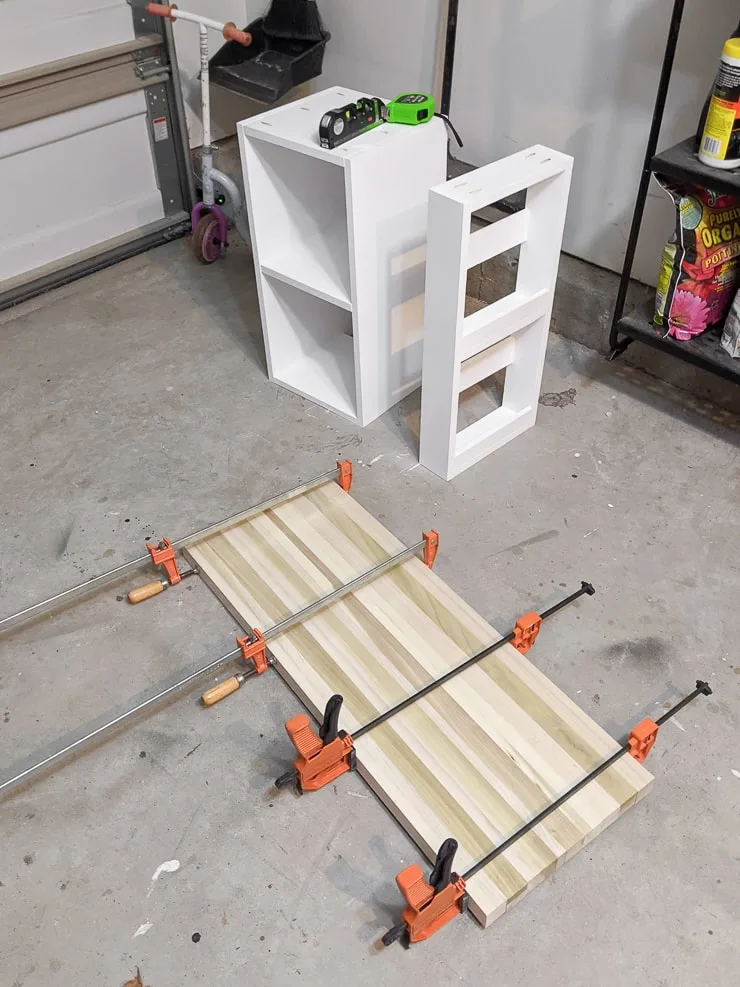Are you wondering if wood glue is enough to secure a tabletop? Well, you’ve come to the right place!
Picture this: You’re sitting at a beautiful, sturdy table, enjoying a delicious meal with your friends and family. But, suddenly, you notice a wobble in the tabletop. Yikes! Nobody wants that.
So, let’s dive into the question at hand: is wood glue enough to keep a tabletop solid and stable? Stick around to find out!
When it comes to building a table top, wood glue alone may not be enough to ensure a strong and durable bond. While wood glue is great for basic woodworking projects, for a table top it’s recommended to reinforce the joints with additional methods such as pocket screws or dowels. This will help provide extra strength and stability to the table top, ensuring it can withstand the daily wear and tear.

Is Wood Glue Enough for Table Top?: A Comprehensive Guide
Wood glue is a popular adhesive used in woodworking projects. It provides strong bonding properties and is commonly used for joining pieces of wood together. However, when it comes to table tops, there are some factors to consider. In this article, we will explore whether wood glue is enough for a table top and discuss alternative options that may be more suitable for this specific application.
The Importance of a Strong and Durable Table Top
When it comes to table tops, durability is key. A table top is subjected to various forms of stress, including weight placed on it, constant handling, and exposure to environmental factors. As such, it is crucial to choose the right adhesive to ensure the longevity and stability of the table top.
Wood glue, while strong, may not always be sufficient for the demands of a table top. While it provides a solid bond between wood pieces, it may not have the necessary properties to withstand the constant stress and strain that a table top experiences. This is especially true for larger or heavier tables that are used frequently.
The Limitations of Wood Glue for Table Tops
There are several limitations to consider when using wood glue for table tops:
- Moisture and Temperature Sensitivity: Wood glue is sensitive to moisture and temperature changes, which can cause the bond to weaken or fail over time. This can be a significant concern for table tops that are exposed to spills, fluctuating humidity levels, or extreme temperatures.
- Limited Flexibility: Wood glue provides a rigid bond, which may not be suitable for table tops that need to withstand small movements or vibrations without compromising the integrity of the joint. Over time, the constant stress can cause the bond to weaken, leading to cracks or separations in the table top.
- Difficulty in Reversibility: Wood glue forms a permanent bond, making it challenging to repair or disassemble the table top if needed. This can be problematic if you ever want to refinish or replace the table top in the future.
Alternative Adhesive Options for Table Tops
While wood glue may not be the ideal choice for table tops, there are alternative adhesive options that offer better durability and performance:
- Epoxy: Epoxy is a popular adhesive for table tops due to its exceptional strength, durability, and resistance to moisture and temperature changes. Epoxy bonds well with different materials, including wood, and provides a more flexible joint that can withstand movement without compromising the integrity of the table top.
- Polyurethane Glue: Polyurethane glue is another suitable option for table tops. It provides a strong bond and has excellent resistance to moisture and temperature changes. Additionally, polyurethane glue expands as it cures, filling any gaps or imperfections in the joint, resulting in a stronger and more stable table top.
- Dowel and Mortise-and-Tenon Joint: In addition to using adhesive, using traditional joinery techniques such as dowels or mortise-and-tenon joints can greatly enhance the strength and durability of a table top. These techniques involve creating interlocking joints that provide additional support and stability to the table top.
Factors to Consider When Choosing an Adhesive
When deciding on the best adhesive for a table top, consider the following factors:
- Intended Use: Determine how the table will be used. Will it be subjected to heavy objects or constant movement? This will help determine the level of durability and flexibility required for the adhesive.
- Environmental Conditions: Consider the environment in which the table will be placed. Is it an indoor or outdoor table? Will it be exposed to moisture, extreme temperatures, or high humidity?
- Size and Weight: Larger and heavier table tops require stronger adhesives that can withstand the increased stress and weight placed on them.
- Repair or Reversibility: If the table top may need to be repaired or replaced in the future, choose an adhesive that allows for disassembly without causing damage.
Choosing the right adhesive for a table top is essential for ensuring its durability and longevity. While wood glue can provide a strong bond for smaller and less demanding projects, it may not be enough for table tops that require exceptional strength, durability, and resistance to environmental factors. Consider alternative adhesive options such as epoxy or polyurethane glue, and incorporate traditional joinery techniques for added support. By carefully selecting the appropriate adhesive, you can create a table top that not only looks beautiful but also stands the test of time.
Key Takeaways: Is Wood Glue Enough for Table Top?
- Wood glue can be an effective option for joining table top pieces together.
- However, it’s important to consider the type of wood and the intended use of the table top.
- For heavy-duty or high-stress applications, additional reinforcement may be needed.
- Factors like humidity, temperature, and moisture can affect the strength and durability of wood glue.
- If in doubt, consider consulting a professional or using other methods like dowels or screws for added support.
Frequently Asked Questions
When it comes to constructing a table, it’s important to choose the right adhesive to ensure a strong and durable tabletop. Here are some frequently asked questions about whether wood glue is enough for a tabletop:
1. What type of wood glue is best for a tabletop?
The best type of wood glue for a tabletop is a high-strength adhesive that is specifically designed for woodworking projects. Look for a glue that is waterproof and provides a strong bond. Polyurethane glue and epoxy adhesive are both excellent choices for tabletop construction. These glues have excellent bonding properties and can withstand the stress and strain that a tabletop may experience.
It’s important to follow the manufacturer’s instructions for the specific glue you choose. Make sure to prepare the wood surfaces properly, apply an even coat of glue, and clamp the joints tightly to ensure a strong bond.
2. Can wood glue alone hold a tabletop together?
While wood glue is a strong adhesive, it may not be enough to hold a tabletop together on its own. Wood expands and contracts with changes in humidity and temperature, which can put stress on the glue joints. To ensure a strong and stable tabletop, it’s recommended to reinforce the glue joints with other methods, such as dowels or biscuits.
By using additional reinforcement, such as dowels or biscuits, you can distribute the stress and strain more evenly across the tabletop, reducing the likelihood of the glue joints failing. This will help to prevent cracks and gaps from forming in the tabletop over time.
3. How long does wood glue take to dry for a tabletop?
The drying time for wood glue depends on the specific type of glue you are using, as well as the environmental conditions. Generally, most wood glues will dry within 24 hours. However, it’s important to note that the glue may still be curing and reaching its full strength for several days after it has dried to the touch.
It’s best to follow the manufacturer’s instructions for the specific glue you are using. Keep in mind that colder temperatures and high humidity can extend the drying time, while warmer temperatures and low humidity can speed it up. It’s important to allow the glue to fully dry and cure before subjecting the tabletop to any stress or strain.
4. Can I use wood glue for outdoor table tops?
While wood glue is a strong adhesive, it may not be the best choice for outdoor table tops. Wood glues are typically not designed to withstand prolonged exposure to moisture, UV rays, and other outdoor elements. Over time, these factors can weaken the glue joints and cause the tabletop to fail.
If you’re building an outdoor table, it’s recommended to use an adhesive that is specifically designed for outdoor use, such as an exterior-grade wood glue or an adhesive formulated for outdoor applications. These glues are designed to withstand the elements and provide a strong and durable bond.
5. Can wood glue be used on different types of wood for a tabletop?
Yes, wood glue can be used on different types of wood for a tabletop. Wood glue works well on a variety of wood species, including hardwoods like oak, mahogany, and walnut, as well as softwoods like pine and cedar. However, it’s important to ensure that the wood surfaces are clean, dry, and properly prepared before applying the glue.
Some woods may require additional surface preparation, such as sanding or using a wood conditioner, to ensure a strong bond. It’s also important to follow the manufacturer’s instructions for the specific type of wood glue you are using, as different glues may have different requirements for application and curing time.

4 Tips for Gluing Clamping a Tabletop
Summary:
When it comes to repairing or building a table top, wood glue might not be enough. While it can be useful for small repairs, it is not as strong or durable as other options. Using additional reinforcement like screws or dowels can help ensure a sturdy and long-lasting table top. So, if you want your table to be sturdy and hold up well over time, consider using more than just wood glue.
In conclusion, wood glue alone may not be strong enough for a table top. It is important to use additional reinforcement like screws or dowels to ensure stability and longevity. So, if you want your table to last, remember to go beyond just wood glue for a stronger and more reliable table top.
